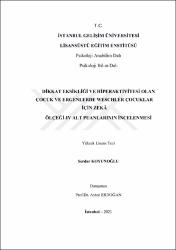| dc.contributor.author | Koyunoğlu, Serdar | |
| dc.date.accessioned | 2021-12-07T08:54:51Z | |
| dc.date.available | 2021-12-07T08:54:51Z | |
| dc.date.issued | 2021 | en_US |
| dc.identifier.uri | https://hdl.handle.net/11363/3071 | |
| dc.description | Danışman: PROF. DR. AYTEN ERDOĞAN
Yer Bilgisi: İstanbul Gelişim Üniversitesi / Lisansüstü Eğitim Enstitüsü / Psikoloji Ana Bilim Dalı / Psikoloji Bilim Dalı
Konu:Psikoloji = Psychology | en_US |
| dc.description.abstract | Dikkat Eksikliği Hiperaktivite Bozukluğu (DEHB), çocuğun akademik ve sosyal yaşamını etkileyen bir bozukluktur. DEHB'li çocuklar dikkat, dürtüsellik, öğrenme ve odaklanma gibi birçok bilişsel alanda sorun yaşamaktadırlar. DEHB‟nin Çalışma Belleği, Yürütücü İşlevler, Psikomotor Hız ve Koordinasyon, İşlemleme Hızı ve Zekâ gibi birçok bilişsel alanda yetersizlikle ilişkili olduğu birçok çalışmada gösterilmiştir. DEHB tanısı koymada dikkat, öğrenme ve bellek gibi bilişsel işlevi değerlendirmede Wechsler Çocuklar İçin Zekâ Ölçeği-Geliştirilmiş Formu (WÇZÖ; Wechsler Intelligence Scale for Children: WISC) kullanılmaktadır. Son yıllarda ülkemizde Wechsler Çocuklar İçin Zekâ Ölçeği-IV (WÇZÖ-IV) standardizasyonu yapılmış olup, bu yeni güncellenmiş formu kullanılmaya başlanmıştır. Amaç: DEHB‟nin beyin prefontal korteksi işlevlerinden olan yürütücü fonksiyonlardan dikkat, dürtü kontrolü yanında öğrenme ve bellek gibi birçok bilişsel işlev bozukluğu ile seyrettiği gösterilmiştir. Değerlendirme ve tanı aşamasında nörokognitif süreçlerin değerlendirilmesinde birçok nöropsikolojik test kullanılmaktadır. Yürütücü fonksiyonları değerlendirmek için nöropsikolojik testlerden Wechsler Çocuklar İçin Zekâ Ölçekleri (WÇZÖ) uygulamada kullanılmaktadır. Bu çalışmada, DEHB ve kontrol grubu bir grup çocukta WÇZÖ-IV kullanılarak, iki grup arasındaki alt test puan farklılıklarını değerlendirmek hedeflenmiştir. Metod: Bu çalışmanın örneklemi, klinik populasyonunda DEHB tanısı alan 6-16 yaş aralığındaki çocuk ve ergen ile DEHB tanısı olmayan 88 çocuk ve ergen kontrol grubundan oluşturulmuştur. Bulgular: DEHB'li grup ile kontrol grubunun aldığı WÇZÖ-IV Zekâ Testi alt ölçek puanları karşılaştırıldığında DEHB'li grubun Çalışma belleği alt test puanları dışında bütün diğer alt test puanlarında kontrol grubundakilere göre istatiksel olarak anlamlı düşüklük tespit edilmiştir. ii Sonuç: DEHB'li grup ile kontrol grubunun aldığı WÇZÖ-IV Zekâ Testi alt ölçek puanları karşılaştırıldığında DEHB'li grubun Çalışma belleği alt test puanları dışında bütün diğer alt test puanlarında kontrol grubundakilere göre istatiksel olarak anlamlı düşüklük tespit edilmiştir. Daha geniş örneklemde DEHB alt tiplerinin ayrıştırılmış olduğu gruplarda çalışmaların yapılması, WISC-IV'ün klinikte tanılamada kullanımına açıklık getirebileceği için önerilir. | en_US |
| dc.description.abstract | Attention Deficit Hyperactivity Disorder (ADHD), is a disorder, seen in childhood that affects the academic and social life of a child. Children with ADHD experience problems in many cognitive domains such as attention, impulsivity, learning, and focus. It has been shown in many studies that ADHD is associated with inadequacy in many cognitive domains such as Working Memory, Executive Functions, Psychomotor Speed and Coordination, Processing Speed, and Intelligence. Wechsler Intelligence Scale for Children - Improved Form is used to (WISC; Wechsler Intelligence Scale for Children) evaluate cognitive function such as attention, learning and memory in ADHD diagnosis. In recent years, Wechsler Intelligence Scale for Children-IV (WISC-IV) has been used for this aim. Aim: It has been shown in many studies that ADHD is associated with the inability in many cognitive domains, such as; Working Memory, Executive Functions, Psychomotor Speed and Coordination, Processing Speed, and Intelligence. Wechsler Intelligence Scale for Children (WISC-R; Wechsler Intelligence Scale for Children-Revized) is used to evaluate cognitive function such as attention, learning, and memory in diagnosing ADHD. In recent years, Wechsler Intelligence Scale for Children-IV (WISC-IV) has been standardized and this new updated form has been used in our country. The main purpose of the study is to reveal the characteristics of WISC-IV in health and ADHD samples and which subtests of the ADHD group have different scores from WISC-IV. Method: The sample of the study consisted of 100 children and adolescents aged 6-16 who were diagnosed with ADHD in a child and adolescent psychiatry clinic in Istanbul, and 88 healthy children and adolescents who were followed in the child health and diseases department of the same private hospital. iv Finding: In our study, when the Verbal Comprehension Test, Perceptual Reasoning, Processing speed and all scale scores of the WISC-IV Intelligence Test sub-dimensions were compared, the scores of children with ADHD were significantly lower than the scores of healthy children. However, when the Working Memory scores from sub-dimension WISC-IV Intelligence Test, were compared among ADHD and normal children, no difference was found. Conclusion: In this study, in which the Verbal Comprehension Test, Perceptual Reasoning, Processing speed and all scale scores of WISC-IV Intelligence Test sub-dimensions were compared; it was found that the scores of children with ADHD were significantly lower than healthy children. It is recommended to conduct studies in groups in which the ADHD subtypes are separated in a larger sample. This may clarify the use of WISC-IV in clinical diagnosis. | en_US |
| dc.language.iso | tur | en_US |
| dc.rights | info:eu-repo/semantics/openAccess | en_US |
| dc.rights | Attribution-NonCommercial-NoDerivs 3.0 United States | * |
| dc.rights.uri | http://creativecommons.org/licenses/by-nc-nd/3.0/us/ | * |
| dc.subject | Dikkat eksikliği ve hiperaktivite bozukluğu | en_US |
| dc.subject | Çocuk ve ergenlerde Zeka | en_US |
| dc.subject | Attention Deficit Hyperactivity Disorder (ADHD) | en_US |
| dc.subject | Intelligence | en_US |
| dc.title | Dikkat eksikliği ve hiperaktivite bozukluğu olan çocuk ve ergenlerde Wechsler çocuklar için zekâ ölçeği-IV alt puanlarının incelenmesi | en_US |
| dc.title.alternative | Investigation of Wechsler intelligence scale for children-IV sub-scores in children and adolescents with attention deficit and hyperactivity disorder | en_US |
| dc.type | masterThesis | en_US |
| dc.department | Lisansüstü Eğitim Enstitüsü | en_US |
| dc.relation.publicationcategory | Tez | en_US |



















